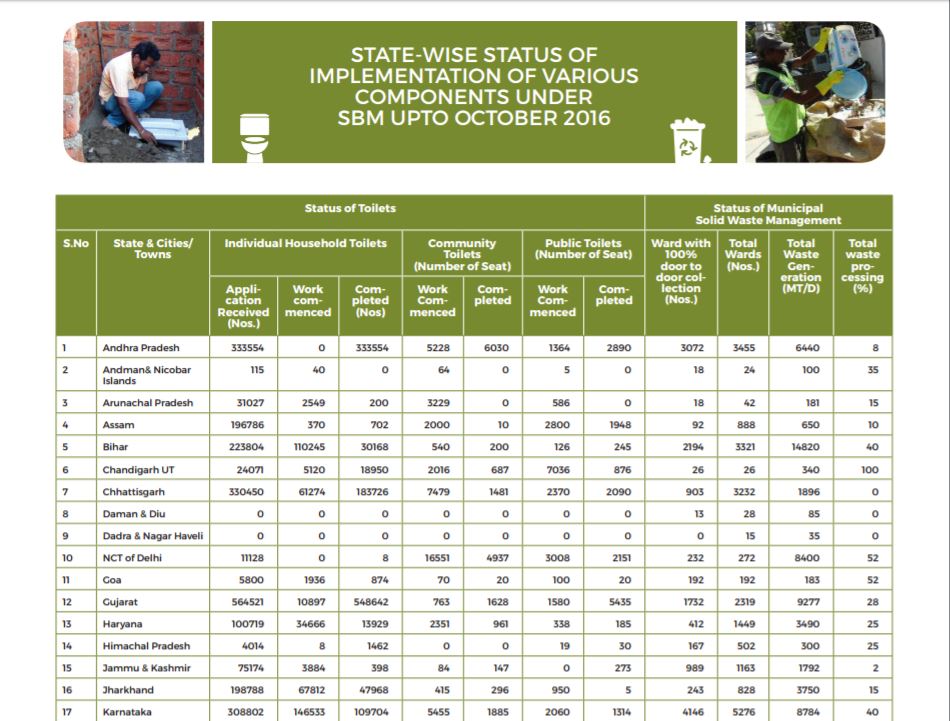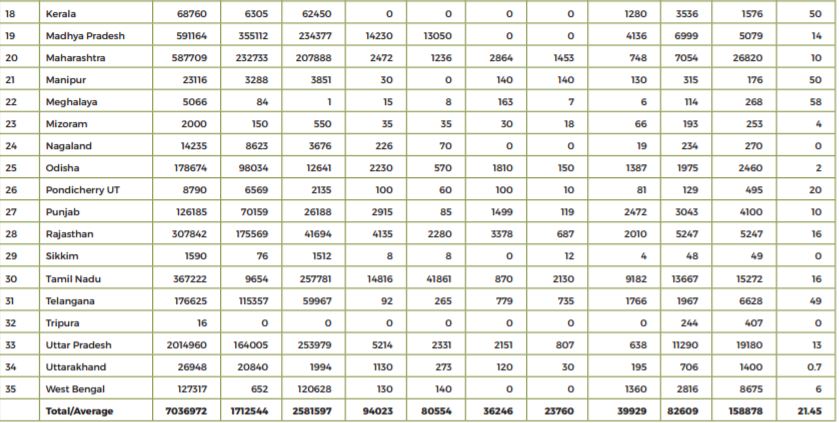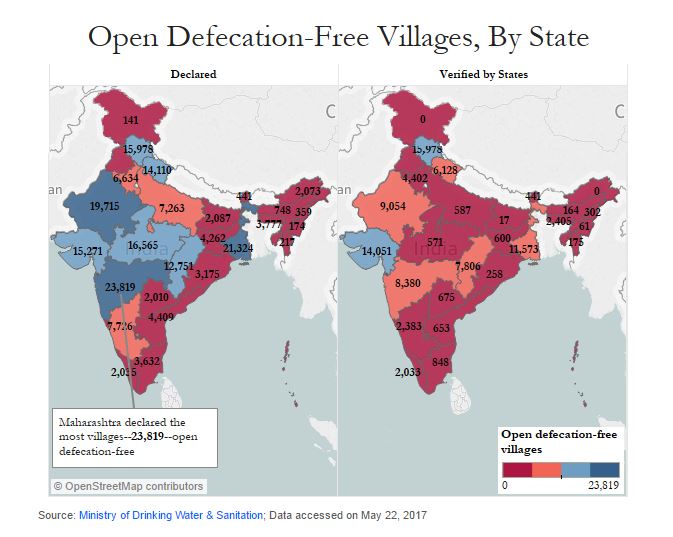
On October 2, 2014, five months after assuming power, Prime Minister Narendra Modi launched the Swachh Bharat Abhiyan. "A clean India would be the best tribute the country could pay to Mahatma Gandhi on his 150th birth anniversary in 2019," the prime minister had said, while talking about the idea behind the initiative.
With the primary objective to reduce open defecation through the construction of individual, cluster and community toilets, the mission aims to achieve an Open-Defecation Free (ODF) India by 2 October 2019 by constructing 12 million toilets in rural India, at a projected cost of Rs 1.96 lakh crore.
Apart from this, the Swachh Bharat Abhiyan also aims to focus on waste segregation and collection, so that recycling becomes a habit. More recently, the clean city drive organised by the government showed how several cities had met with parameters to ensure that the dream of a Swachh Bharat was fulfilled.
PM Modi's initiative to end open defecation is a step in the right direction. After all, open defecation results in faeces getting mixed with drinking and bathing water across the country, thereby resulting in the outbreak of diseases. As per data provided by UNICEF, one gram of adult human excreta consists of 1,00,000 bacteria, 1,000 parasite cysts, and 10,000,000 viruses.
The diseases that result from open defecation are water-borne diseases such as diarrhoea, typhoid, cholera, hepatitis, polio, trachoma, amongst others
With two years left, the mission has a long way to go, as data from the Swachhta Status Report from the National Sample Survey Office 2016 suggests. According to that report, 8.9% of urban India has to opt for open defecation, while 55.4% in rural India have to defecate in the open.
The number of individuals openly defecating in rural India has increased from the previous year. In the previous 2015 report, it was suggested by the Swachhta Status report that 52.1% of rural India still defecate in the open.
The Centre for its part, despite the increase in numbers, has been doing its bit to construct toilets across the country. As per data provided by the Swachh Bharat website, 70.3 lakh applications for individual toilets have been received. Of this, 25 lakh toilets have been completed, while work on 17 lakh toilets have commenced. Similarly, 80,554 community toilets have been completed, while work on 94,023 have commenced. When it comes to public toilets, the government says it has completed 23,760, while 36,246 are being completed.


The situation of toilets in India - Source: Swachh Bharat website
To meet the 2019 deadline, the government, too, has started using innovative methods to ensure that people use toilets. Haryana has drones monitoring people who openly defecate, while the Madhya Pradesh government has passed a bill that says people who don't have a toilet at home won't be able to contest panchayat elections. Similarly, Chhattisgarh has a law that says that those without a toilet at home won't have access to public distribution ration.
More recently, the mission teamed up with Google to launch the toilet locator so that urinating in public will come to an end
According to data accessed by Indiaspend, 40 million household latrines have been constructed since 2014. "Betweeen May 1 and May 21, 2017, 4,89,710 individual household latrines were constructed across the country, as per data from the Swachh Bharat Mission-Gramin website. That's an average of nearly 25,000 toilets constructed per day," the report added.

The Indiaspend report adds that Gram Panchayats have self-declared 1,93,081 villages to be open defecation-free, but 53.9% of these have not been verified, according to the Ministry of Drinking Water and Sanitation.
Recently, a parliamentary panel said that India will miss its target of becoming open defecation free by 2019 due to “insufficient allocation of funds” under Prime Minister Narendra Modi’s much publicised ‘Swachh Bharat Abhiyan’
Expressing concern over reduction in funds for the clean India mission, the Standing Committee on Rural Development in its report noted that drinking water and sanitation were crucial areas and that the financial aid in these areas should not be reduced. The Department of Drinking Water and Sanitation under the Rural Development Ministry is the nodal authority for implementation of the clean India mission.
The conclusion is that while the mission to make India open defecation free is a noble one, latrine construction is not enough to substantially reduce open defecation. The government needs to rethink its strategy and promote latrines on a large-scale manner.
Prime Minister Modi has asserted that the aim of the government is to spend at least 2.5 percent of Gross Domestic Product (GDP) in the health sector in the coming years.
During the 2017-18 budget, finance minister Arun Jaitley announced that the government had targeting the elimination of tuberculosis by 2025 (WHO statistics in 2011 said that out of 9.5 million global cases, India had the highest with 2.2 million). To counter this disease, Jaitley announced that 1.5 lakh health sub-centres will be transformed into health and wellness centres.
The overall health budget has increased from Rs 39,879 crore (1.97% of total Union Budget) to Rs 48,878 crore (2.27% of total Union Budget). However, reports suggest that most of the funds have been concentrated towards human resources and medical education.
However, in 2015, the government had announced that most of the sourcing of care came from the private sector. At the time, it was also announced that public spending on health in India is shared by the Central government and the 29 states, with the primary and secondary health system being funded by the states, while the central government funds other healthcare aspects such as population control, nutrition, medical education, and programmes on communicable and non-communicable diseases.
In 2015, 26.7 crore Indians suffered from non-communicable diseases (NCDs). The data is divided as follows – 6.5 crore suffer from cardiovascular disease, 2.65 crore suffer from mental illness, and 3.11 crore suffer from respiratory disorders. The numbers for cancer and diabetes were not available, an Indian Council of Medical Research report in 2016 suggested that the country is likely to have over 17.3 lakh new cases of cancer and over 8.8 lakh deaths due to the disease by 2020 with cancers of breast, lung and cervix topping the list. In fact, the leading killer in India are non-communicable diseases, followed by diarrhoea.
The Government of India says it is taking immediate action and targeting the greatest risk factors contributing to NCDs—unhealthy diets, physical inactivity, tobacco and alcohol use, and air pollution. In villages, local bodies, in partnership with the Centre, have encouraged people not to use chulas or biogas stoves, as they can damage the lungs, while every budget increases the price of cigarettes, bidis, and other tobacco-based products.
According to data provided by the government, 2.7 crore children are born in India every year. Approximately 18.3 lakh children die before their fifth birthday. It is the low income families who lose the most children to disease. India records 5 lakh child deaths annually due to vaccine preventable diseases. Despite high childhood mortality rates due to vaccine preventable diseases, 30 percent of Indian children miss the benefits of full immunization every year. That is, an estimated 89 lakhs children across the country that either get only a few vaccines or no vaccines at all. One out of every 3 children in India does not receive all vaccines that are available under UIP. Five percent of children in urban areas and 8 percent in rural areas are not immunised.
Secondly, as per data, from Indhradhanush, an organisation set up by the health ministry in 2014 to immunise children under the age of 2, as well as pregnant women, 28.2% of parents who did not opt for vaccination, felt that there was no need for it. 26.3% did not know of the vaccine, while 10.8% did not know where to go. Another 9% felt that the time wasn’t convenient, while 8.1% feared side-effects of vaccinations. 3% received wrong advice, while 1.2% couldn’t afford it.
Other problems are fake news stories that are circulated through mediums such as WhatsApp. According to a report in Scroll, a WhatsApp audio message discouraging parents from letting their children be vaccinated went viral in some Tamil Nadu and Karnataka communities. The message falsely claimed that the vaccine is intended to make children from minority communities impotent.
While presenting the budget this year, Finance Miniser Arun Jaitley said that the government has plans of eliminating filariasis by 2017, leprosy by 2018, measles by 2020 and TB by 2025. A few months earlier, the immunisation division of Union Health Ministry had projected that the government's immunisation budget will increase to Rs 9,451 crore in 2017. It was Rs 4,570 crore in 2013, based on the vaccines' cost and related expenditures.
While India's government data suggests that we're in the right direction, there are still several obstacles that the government faces. This starts by educating the masses on the advantages of using a toilet, segregating waste, and thereby preventing disease. Along with this, a dedicated budget towards R&D would also add value to the Prime Minister's Make in India Vision. And even if we don't meet the 2019 target, taking it one step at a time to achieve something monumental will be the biggest achievement made by this government.